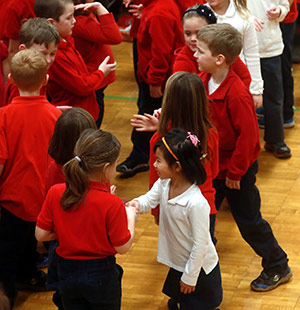 It’s amazing how mysteriously God works through our lives.
It’s amazing how mysteriously God works through our lives.
For example, people often ask me how I choose a topic for this column. I reply that ideas come from what I read, see, hear; from reflecting on my own life, time with my grandchildren and current events. Sometimes I pray for inspiration.
Although at first I failed to see a connection, the idea for this column came from an article in the Family Section in the October Catholic Herald titled, “Refuel your faith by attending a children’s Mass.”
The story reminded me of my grade school days, some 70-75 years ago at St. Frederick Parish, Cudahy, when all students attended morning Mass every school day.
 Children from the Kenosha Catholic schools exchange the Sign of Peace at a city-wide Mass Monday, Jan. 26, at St. Joseph Catholic Academy, Kenosha. Columnist Gene Horn observes that children regularly participate in school Masses by introducing the Mass theme, carrying the crucifix in the entrance procession, serving on the altar, reading, reciting petitions and presenting the gifts. (Catholic Herald photo by Allen Fredrickson)
Children from the Kenosha Catholic schools exchange the Sign of Peace at a city-wide Mass Monday, Jan. 26, at St. Joseph Catholic Academy, Kenosha. Columnist Gene Horn observes that children regularly participate in school Masses by introducing the Mass theme, carrying the crucifix in the entrance procession, serving on the altar, reading, reciting petitions and presenting the gifts. (Catholic Herald photo by Allen Fredrickson)
At St. Roman Parish, where I am a member, school children attend Mass only weekly, on second, third and fourth Tuesdays.
Why weekly vs. daily Mass? Here’s why:
St. Roman School children come to Mass as participators. In the 1930s and ’40s, Catholic school children attended Mass as spectators.
At St. Frederick, daily Mass was routine. From our classroom we marched into church. Sister/teacher snapped a rubber band on her prayer book. Automatically we genuflected and filled the pews. We knelt, sat and stood. Mass was offered in Latin. The priest faced the altar. There was no homily. Some 20-30 minutes later, we returned to the classrooms. We received holy Communion only on Sundays and holy days.
At St. Roman and other Catholic schools, children are involved in all aspects of their hourlong weekly Mass, from the planning in the classroom to the concluding prayer in church. The youngsters, with their teachers, decide who will do what, when and how.
The time required to plan a prayerful and meaningful liturgy is substantial. Considering all other educational requirements and activities, preparation for Mass on a daily basis would be burdensome for teachers and pupils.
At St. Roman, students in all eight grades plan and participate on a rotating basis. Occasionally, kindergarteners read petitions. Masses focus on lives of saints, feast days, holy days, special occasions or on themes of peace, love, honesty, friendship, care and concern for others.
Children’s participation includes: introducing the Mass theme, carrying the crucifix in the entrance procession, serving the priest at the altar, reading from the Old Testament, reciting petitions, presenting the gifts to the celebrant, praying, singing, sharing a sign of peace with each other, receiving holy Communion and, at times, concluding with a theme-based artwork presentation. Teachers guide the participants through the Mass and serve as ministers of the Eucharist and cup.
In the October Catholic Herald, columnist Michelle Campbell noted that attending a children’s Mass you will see:
A kindergarten girl approach the ambo, face the microphone from a step stool and read a petition followed by “wet us pway to the Lord.”
A second-grader proceed to wipe his nose on his sleeve before reciting the first reading.
A sixth-grader bow with reverence before reading the introduction.
An eighth-grader genuflect and make the sign of the cross with lightning speed without reservation.
What Campbell described is similar to what happens at St. Roman, where you’ll also hear a homily translated to the level of children’s understanding by our parish priests, Frs. Brian Holbus, Christopher Klusman and John Pulice. And, led by Fr. Klusman, who is deaf, you’ll see children and adults proclaiming the alleluia in sign language.
Longtime first-grade teacher Judy Kozup said preparation for each children’s Mass requires ample time and practice with participating youngsters – in the classroom, in church, after school and at home.
Kozup said reading from Scripture is voluntary for upper-grade students while readers in lower grades are selected by teachers. At some Masses, children display artwork to illustrate a feast day, holy day or special occasion theme.
“It’s all worth the effort,” Kozup said, adding that children’s participation also encourages parents and grandparents to attend.
Fred Bach, music teacher, who plays organ and piano at children’s Masses, said teachers who choose the music, are challenged to select the songs that appeal to children across all grade levels. He said preparation requires rehearsal and practice during class and after school.
“It takes a lot of time,” he noted.
It’s amazing and inspiring to see these youngsters standing at the ambo proclaiming the Word of God. Some are neither articulate nor eloquent. They may not speak loudly and clearly like adult lectors, but they’re up there doing it from the heart in front of some 300 schoolmates. I admire them. In the ol’ days, school children at Mass were seen, but not heard.
A major improvement from the past, along with the Mass in English, is the ability to receive the Eucharist at every Mass, due to a change in fasting rules initiated in 1953.
Reception of Eucharist at weekday Masses was rare, mainly because fasting from food and liquid, including water, began at midnight.
But with the advent of afternoon and evening Masses after Vatican Council II, Pope Paul VI decreed in November 1964 that people should fast from liquids for one hour before receiving Communion, although water and medicine may be taken at anytime.
Reflecting on the past and witnessing the present, I can’t envision myself as a grade schooler participating in the Mass as seen at St. Roman.
It’s wonderful to see these youngsters actively involved in the Mass at all levels. Credit the teachers and staff who are dedicated to Catholic education and the care and concern for their students for providing the preparation and training to make it happen.
Prayerfully, liturgical participation that St. Roman and other Catholic school students provide will be nurtured by teachers and parents.
Hopefully, they will be inspired and encouraged to continue their service to the church as they progress into adulthood – as lectors, Eucharistic ministers, servers, cantors, choir members and parish leaders.
To best describe children’s Mass at St. Roman and other Catholic schools: It’s awesome!
(Out and About is a regular feature of Mature Lifestyles that looks at issues affecting the older adult community. Horn, a retired Catholic Herald reporter, is a member of St. Roman Church, Milwaukee.)
